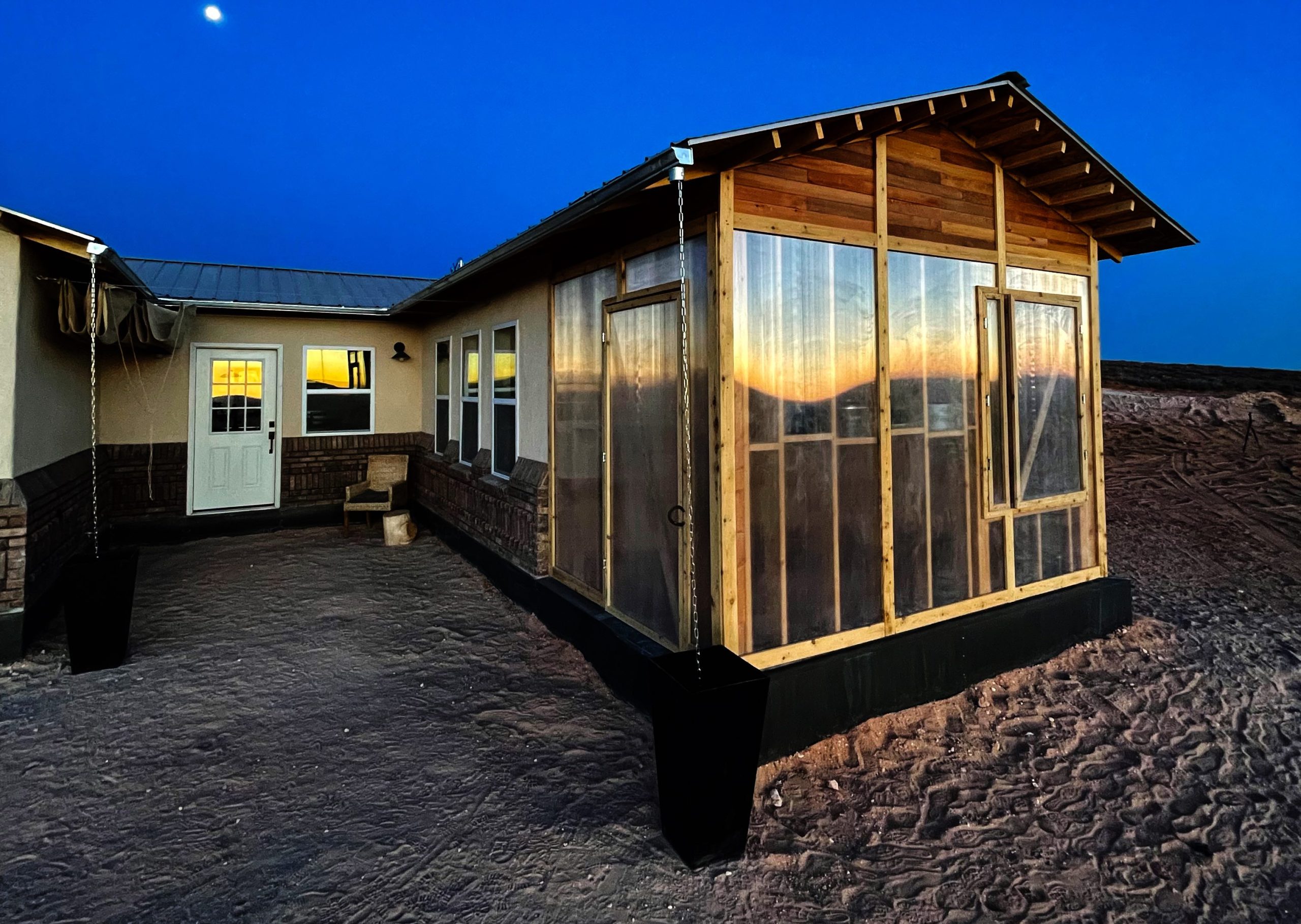Some information may be outdated.
Eight architecture students from the University of Utah will spend the rest of the year designing and building a home for a family on the Navajo Nation. The recipient will pay nothing, but will help build their own home.
The students spent the weekend of May 13 among the buildings of DesignBuildBLUFF’s campus, made of shipping containers, recycled plastic, blocks of coal ash and other recycled and salvaged materials. After touring homes on the Navajo Nation, they gathered in one of the sunlit buildings for a question and answer session with previous participants in the program.
Adrienne Caesar and Molly Schmidt, who both came to the program as long term volunteers by way of Yestermorrow Design/Build School in Vermont, made it clear as they fielded questions that the students’ preconceived notions were about to change.
Caesar recounted asking Tony Dayish, Executive Director of Utah Navajo Trust Fund, if his clients were curious about living off-grid. “He was like, ‘Well, yeah, everyone lives off grid.’”
“It doesn’t have that niche meaning that it does in architecture,” Caesar said.
Schmidt had advice for the students as they interacted with tribal members:
“The idea of recycling is actually not really possible in some places out here,” she said. “And so not putting any shame to like, ‘Oh shouldn’t you want solar panels?’ Or, ‘shouldn’t you want to be able to recycle?’ ‘Shouldn’t you want to collect water?’ I think you might ask your sustainability question a little differently.”
Sweat Equity
DesignBuildBLUFF was originally founded in 2004 by University of Utah professor Hank Louis. Hiroko and Atsushi Yamamoto have been resident staff instructors of the program since 2013, when the University of Utah absorbed the nonprofit.
Hiroko explained that since 2017 the program has been using a “sweat equity” model for building homes on the Navajo Nation, where families collaborate on the build in lieu of monetary payment.
Instead of “client” or “recipient,” DBB uses the term “collaborative resident” to reflect this relationship.
To be selected for the program, Hiroko explained, residents first need a homesite lease, an arrangement where a homeowner rents the land under them for $1 per month. Then they apply for funding for materials through the Utah Navajo Trust Fund or the Navajo Revitalization Fund.
DBB then approaches the local Chapter House to find out who meets the criteria, and who is willing to work with them, Atsushi added. DBB provides the design and the labor for free.
DBB designs homes to be expandable, but it doesn’t guarantee completion in the 12-week building semester, Hiroko continued. The students prioritize the core aspects of the home (often the structure and wet areas) so that residents can move in at the end of the program. Along the way, they help the resident learn the skills to complete and expand the house.
In one recent build, DBB wasn’t able to finish the interior drywall, but the resident was able to finish the drywall and paint over the winter.
Hiroko believes this is a better arrangement for the long run than simply giving away a finished home. “They have ownership for this house… I believe they can keep maintaining this house in the future,” she said.
The builds include contemporary building techniques and materials as well as some local, natural elements like plaster from the earth taken from the foundation.
The houses also often have to be liveable off-grid.
“They have to wait two to three years or sometimes 10 years to connect the water to the house, but at least they can stay in the house,” Atsushi said.
22 houses have been built on the Navajo Nation through DBB, along with several other projects around Bluff. More than 290 students have participated, according to the program’s website.
The students are excited.
“Because I use a wheelchair, I thought that it would be fun to kind of challenge myself physically, and see how that would work living here on campus and building in the middle of nowhere,” said Heather Leighton. She chose DesignBuildBLUFF over another design build program because of its orientation to the Navajo people.
Preeti Gurung, an international student, had her definition of “rural” upended over the weekend. “It was kind of shocking for me to see that it is a village but at the same time they don’t live in a cluster.”
Both students were surprised to learn that one of the homeowners they visited had to wait 35 years to build her home after getting her homesite lease approved.
Part of an ecosystem
During the Q&A, students asked about the Nááts’íilid Initiative, part of the ecosystem of groups creatively solving building and infrastructure shortages on the Navajo Nation. It’s an Indigenous-led community development collaborative which recently hired Caesar.
In addition to building sweat equity homes in three chapters of the Navajo Nation, Nááts’íilid is also working on installing an autonomous solar microgrid and broadband connections for a community in the Kayenta chapter. 24 homes in the community are not connected to electricity, despite being two miles from a solar power plant, according to the organization’s website.
Caesar said Nááts’íilid was awarded a $3.7 million grant from the U.S. Department of Energy for the project.
Schmidt said that all the organizations —DBB, Nááts’íilid, Yestermorrow, as well as the town of Bluff—are supportive of one another. “There’s a reason that Hiroko, Adrienne, Atsushi and I all collaborate, and sometimes it’s blurry.”
“If you leave with more questions than answers, you will have had a successful DesignBuildBLUFF experience,” Schmidt told the students.
The students will design the home over the summer before starting the build in the fall.
To donate materials to DesignBuildBLUFF or to volunteer, email hiroko@arch.utah.edu. To get involved with the Nááts’íilid Initiative, start at www.naatsiilid.org.
Appreciate the coverage? Help keep local news alive.
Chip in to support the Moab Sun News.





